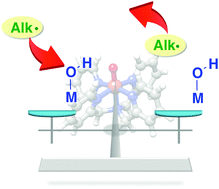To rebound or dissociate? This is the mechanistic question in C–H hydroxylation by heme and nonheme metal–oxo complexes†
Abstract
Enzymatic reactions that involve C–H bond activation of alkanes by high-valent iron–oxo species can be explained by the rebound mechanism (RM). Hydroxylation reactions of alkane substrates effected by the reactive compound I (Cpd I) species of cytochrome P450 enzymes are good examples. There was initially little doubt that the rebound paradigm could be carried over in the same form to the arena of synthetic nonheme high-valent iron–oxo or other metal–oxo complexes. However, the active reaction centres of these synthetic systems are not well-caged, in contrast to the active sites of enzymes; therefore, the relative importance of the radical dissociation pathway can become prominent. Indeed, accumulating experimental and theoretical evidence shows that introduction of the non-rebound mechanism (non-RM) is necessary to rationalise the different reactivity patterns observed for synthetic nonheme complexes. In this tutorial review, we discuss several specific examples involving the non-RM while making frequent comparisons to the RM, mainly from the perspective of computational chemistry. We also provide a technical guide to DFT calculations of RM and non-RM and to the interpretations of computational outcomes.


 Please wait while we load your content...
Please wait while we load your content...